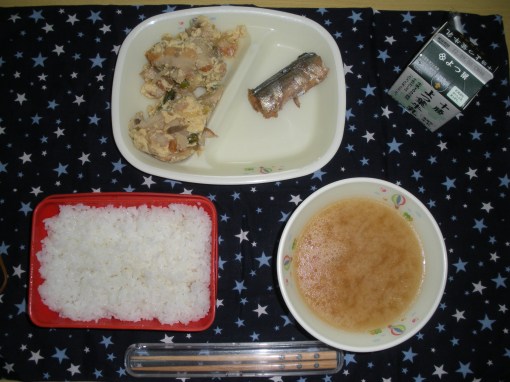February 25th, Monday:
- Scallop Soup (Scallop, Tofu, Carrot, Chinese Cabbage, Burdock)
- Simmered Dried Sliced Daikon (Dried Sliced Daikon, Satsuma-age, Hijiki Seaweed, Carrot, Green Bean, Sliced Konnyaku)
- Plum Simmered Saury
- Rice
- Milk
- Kcal: 846
Tofu 「豆腐」 is a food handed down from China. The character fu 「腐」does not mean “rotten” in China, but means “something gathered from a liquid to make something firm out of something soft”.
To explain what the kyuushoku tayori means by the above, I should say that 腐 means rotten in modern Japanese, so the characters for tofu seem to literally say “rotten beans”, which does not sound the most appealing.
Anyways, the saury fish today is not that beautiful and rather hard to eat, but being plum-simmered gives it a really nice taste. I say this as a very picky eater. So frightening to behold, but delicious. I like hijiki and satsuma-age and konnyaku so much, so I really liked the simmered daikon, but judging from my students plates, the saury was far more popular than the daikon….
Other exciting things today was one of the boys split his entire soup all across his lap and we got to eat ぼっけもんsweets by 風月堂 from Kagoshima prefecture, since the superintendent brought them back as omiyage! I ate it before I could take a picture. I’m sorry.
- ほたて汁
- 切り干し大根煮
- さんまの梅煮
- ごはん
- 牛乳









